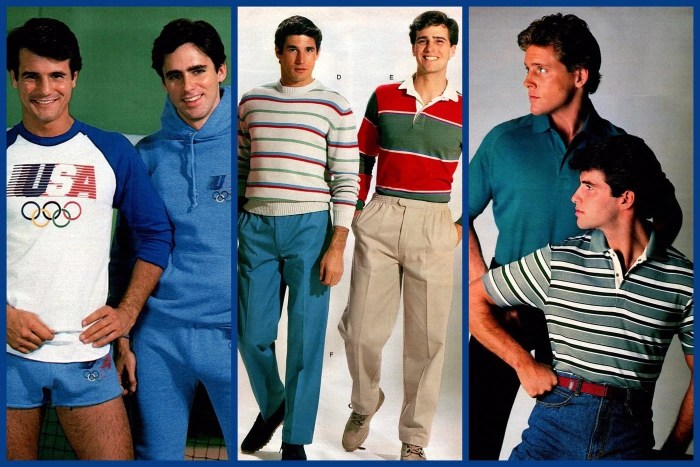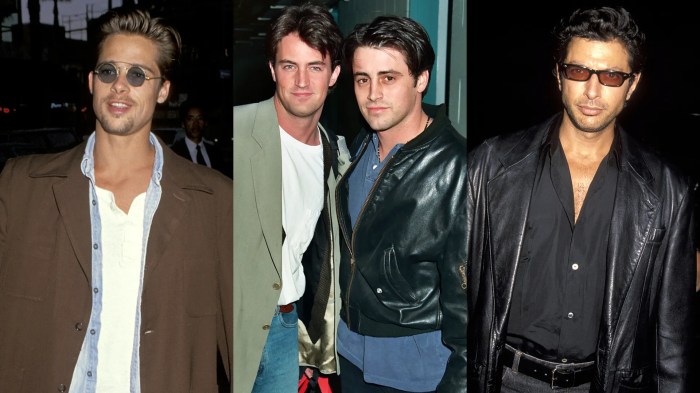Key Garments and Accessories: 80s Men’s Fashion Pictures

80s men’s fashion pictures – The 1980s witnessed a vibrant and often flamboyant evolution in men’s fashion, characterized by a blend of power dressing, athletic influences, and a playful experimentation with color and silhouette. Understanding the key garments and accessories of this era is crucial to appreciating its unique aesthetic. This section will explore five essential garments and the significant role of accessories in shaping the 80s menswear landscape.
Essential Garments of 1980s Men’s Fashion
The decade’s menswear was defined by a range of distinct styles, reflecting the diverse cultural influences and economic prosperity of the time. Five garments stand out as particularly representative of the era.
- The Power Suit: The quintessential 80s garment, the power suit embodied ambition and success. Typically crafted from wool or a wool blend, it featured broad shoulders, a structured silhouette, and a longer jacket length. Variations included pinstripes, bold colors like navy, grey, or even burgundy, and double-breasted styles. The silhouette aimed for a powerful, almost imposing look.
- The Leather Jacket: Leather jackets, often in black or brown, represented a rebellious yet sophisticated edge. From biker-inspired styles to more tailored versions, they offered a versatile option for both casual and semi-formal occasions. Variations included different leather types, detailing like zippers and studs, and varied fits from slim to oversized.
- Denim Jeans: While jeans had existed before, the 80s saw a rise in their popularity as a versatile staple. High-waisted, straight-leg styles were common, often paired with a tucked-in shirt or sweater for a more polished look. Stonewashed denim and acid-washed denim were particularly trendy, reflecting the era’s embrace of casual styles.
- The Sweater Vest: Often worn over a collared shirt or turtleneck, the sweater vest provided a layer of warmth and a touch of preppy sophistication. Argyle patterns, cable knits, and V-neck styles were popular choices. They offered a comfortable and stylish alternative to a full sweater, adding texture and visual interest to an outfit.
- The Turtleneck: The turtleneck became a staple for both casual and more formal occasions. Worn alone or under a blazer, it provided a sleek and sophisticated look. The material ranged from fine merino wool to heavier knits, reflecting the varied styles of the era. Solid colors, particularly black, navy, and grey, were most common.
Accessories in 1980s Men’s Fashion, 80s men’s fashion pictures
Accessories played a crucial role in completing the 80s look, often adding a touch of personality or enhancing the overall style.
Watches: Large, bold watches, often featuring gold or stainless steel bands, were highly sought after. Brands like Rolex, Omega, and Patek Philippe were particularly popular, reflecting the aspirational nature of the era. The size and style of the watch often served as a statement piece.
Belts: Leather belts, often wide and featuring prominent buckles, were a key accessory. The buckle itself could be a significant design element, with variations ranging from simple to highly ornate. The belt added structure and definition to an outfit, complementing the broad-shouldered silhouette of the power suit.
Sunglasses: Aviator sunglasses, Wayfarers, and other bold styles were ubiquitous. Sunglasses served both a practical and a stylistic purpose, adding a cool and sophisticated touch to the overall look. Tortoiseshell frames were particularly fashionable, reflecting the era’s fondness for classic designs with a modern twist.
The Evolution of Sportswear in the 1980s
The influence of sportswear on mainstream menswear in the 80s was profound. The rise of fitness culture and athletic brands like Nike, Adidas, and Reebok contributed significantly to this shift.
Brands like Nike and Adidas, initially focused on athletic performance, began producing apparel suitable for everyday wear. Tracksuits, sneakers, and athletic-inspired shirts transitioned from the gym to the streets, blurring the lines between athletic and casual wear. The vibrant colors and bold logos of these brands became iconic symbols of the era. This integration of sportswear into everyday fashion marked a significant change in menswear, paving the way for the athleisure trend seen in later decades.
Color Palettes and Fabrics
The 1980s witnessed a vibrant explosion of color and texture in men’s fashion, reflecting the decade’s bold and often excessive aesthetic. These choices weren’t merely stylistic; they mirrored broader cultural shifts, from the rise of materialism to the influence of burgeoning subcultures.The dominant color palettes of 80s menswear showcased a striking contrast between bright, bold hues and more subdued, sophisticated tones.
The decade’s association with power dressing saw the prevalence of deep, rich colors like navy, burgundy, and charcoal gray, often in sharply tailored suits. These colors projected an image of authority and success, aligning with the ambitious spirit of the era’s corporate landscape. Conversely, a playful counterpoint emerged with the popularity of neon shades – shocking pink, electric blue, and vibrant lime green – particularly in sportswear and casual wear, reflecting a youthful energy and a rejection of traditional formality.
Pastel shades also found their place, often seen in softer, more relaxed styles.
Color Combinations and Patterns
The interplay of these diverse color palettes created some memorable and, to modern eyes, often striking combinations. Think of a navy pinstripe suit paired with a shocking pink shirt, or a burgundy blazer worn over a pastel-colored sweater. Geometric patterns, especially bold stripes and checks, were incredibly popular, often featured in both suits and casual shirts. Subtle patterns like houndstooth and argyle also maintained their presence, offering a more refined alternative to the bolder choices.
Browsing through 80s men’s fashion pictures often reveals a fascinating array of styles. The influence of classic outerwear is undeniable, and a key piece to consider within this context is the trench coat. For a deeper dive into the sophisticated appeal of this garment, particularly within Asian menswear, check out this resource on asian men trench coat fashion.
Returning to the 80s, the versatility of the trench coat makes it a timeless addition to many of the era’s iconic looks.
A visual representation of these combinations might depict a grid: one quadrant showcasing a deep navy suit with a crisp white shirt, another a bright pink polo shirt with white trousers, a third featuring a pastel-toned sweater with beige chinos, and a final quadrant demonstrating a bold striped shirt paired with dark denim. This grid would capture the range of styles and color combinations prevalent during this era.
Fabric Choices in 80s Menswear
The fabrics used in 80s menswear reflected the diverse styles of the decade. Power suits were typically crafted from high-quality wool, often in heavier weights to create a strong silhouette. This contrasted sharply with the rise of synthetic fabrics like polyester and rayon, frequently used in sportswear and more casual garments. These synthetics offered a sheen and a certain level of durability, but often lacked the breathability and natural drape of natural fibers.
Leather, a material often associated with rebellion and a tougher image, was also popular, appearing in jackets, accessories, and even some pants. Denim, a staple fabric, saw a resurgence, with various washes and styles reflecting the diverse trends of the time – from acid-washed jeans to stonewashed denim jackets. The juxtaposition of these fabrics – the formality of wool, the sporty feel of synthetics, the rebellious edge of leather, and the casual comfort of denim – encapsulated the stylistic contradictions of the 80s.
Evolution and Legacy

The 1980s witnessed a dramatic shift in men’s fashion, evolving from the more subdued styles of the 1970s to a decade characterized by bold experimentation and a flamboyant aesthetic. This evolution wasn’t linear; rather, it saw distinct phases, each reflecting the changing social and cultural landscape. The decade’s legacy continues to influence contemporary menswear, with specific elements experiencing periodic revivals and reinterpretations.The early 1980s retained some vestiges of the previous decade’s styles, with a focus on tailored suits, though often in brighter colors and bolder patterns than seen in the 1970s.
The rise of the “power suit,” epitomized by broad shoulders, double-breasted jackets, and high-waisted trousers, became a dominant force, reflecting the burgeoning yuppie culture and the emphasis on corporate success. As the decade progressed, a more casual, athletic-inspired aesthetic emerged, influenced by the burgeoning popularity of fitness and workout culture. This led to the integration of sportswear elements like tracksuits, sneakers, and bomber jackets into everyday wardrobes.
The late 1980s saw a further diversification of styles, with the emergence of grunge influences foreshadowing the fashion trends of the 1990s.
The Transition from Power Dressing to Casual Wear
The shift from the formal power suit to more relaxed styles throughout the 1980s mirrored broader societal changes. The initial emphasis on sharp tailoring and conformity gradually gave way to a more individualistic approach to dressing. This transition is clearly visible in the evolution of popular menswear icons. Early 80s style icons like Michael Douglas in
- Wall Street* showcased the peak of power dressing, while later in the decade, figures like Tom Cruise in
- Top Gun* represented a move towards a more athletic and less rigidly formal look. This shift wasn’t abrupt; instead, it involved a gradual blending of formal and informal elements, leading to the layering of pieces and the incorporation of casual wear into otherwise formal outfits.
The Enduring Influence on Contemporary Menswear
The legacy of 1980s menswear is undeniable. Elements such as bold colors, oversized silhouettes, and athletic-inspired designs continue to reappear in contemporary collections. The re-emergence of the bomber jacket, for instance, is a testament to the enduring appeal of this 80s staple. Similarly, the influence of 80s sportswear can be seen in the popularity of track pants, sneakers, and athletic-inspired streetwear.
The revival of certain 80s trends often involves a modernized interpretation, incorporating contemporary fabrics and cuts while retaining the essence of the original design.
Reinterpretations and Revivals of 80s Styles
Many designers have drawn inspiration from 1980s menswear, reinterpreting iconic styles for modern audiences. The resurgence of the oversized blazer, for example, reflects a contemporary take on the broad-shouldered jackets of the era. However, modern interpretations often incorporate slimmer fits and more contemporary fabrics, creating a balance between nostalgia and modern aesthetics. Similarly, the re-emergence of brightly colored tracksuits and sneakers, frequently seen in high-fashion collaborations, demonstrates the ongoing relevance of 80s sportswear.
These revivals often incorporate updated details, such as premium materials and innovative construction techniques, to appeal to a contemporary consumer base. The reinterpretation of the classic 80s bomber jacket, for example, often involves the use of high-quality leather or innovative textiles, while maintaining the silhouette and detailing of the original design.
User Queries
What were some common hair styles for men in the 80s?
Big hair was a defining feature! Think teased, voluminous styles, mullets, and jheri curls.
How did athletic wear influence 80s men’s fashion?
Athletic brands like Nike and Adidas became increasingly mainstream, influencing casual wear with tracksuits, sneakers, and brightly colored sportswear.
What role did technology play in 80s men’s fashion?
The rise of synthetics like Lycra allowed for new fits and styles, while advancements in manufacturing led to more readily available and affordable clothing.
Were there any significant differences in 80s men’s fashion across different countries?
While many trends were global, regional variations existed. For example, Italian fashion often emphasized tailoring and luxurious fabrics, while American styles often leaned towards a more casual or athletic look.
